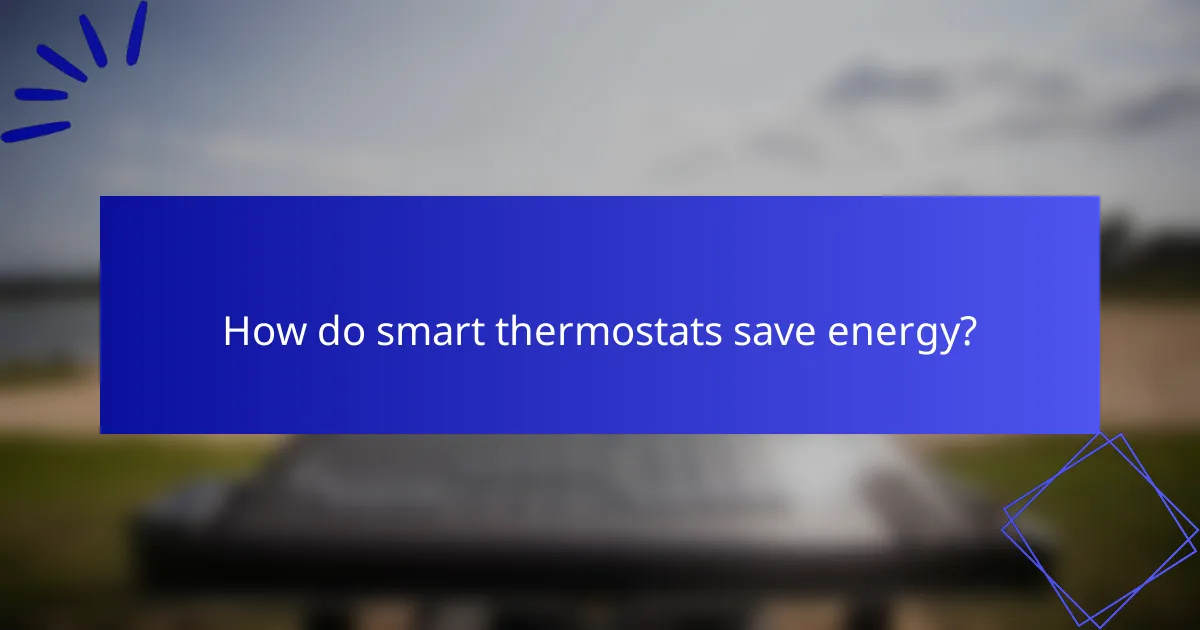Smart thermostats are designed to enhance energy efficiency by automatically adjusting heating and cooling schedules based on user habits and environmental factors. By optimizing comfort while reducing energy consumption, these devices can lead to significant savings on utility bills. When choosing a smart thermostat, it’s essential to consider features like Wi-Fi connectivity, compatibility with your HVAC system, and user-friendly controls to ensure a seamless integration into your home. Brands like Ecobee, Nest, and Honeywell offer a variety of options tailored to different needs and preferences.

How do smart thermostats save energy?
Smart thermostats save energy by optimizing heating and cooling schedules based on user behavior and environmental conditions. They adjust settings automatically to maintain comfort while minimizing energy consumption, leading to lower utility bills.
Adaptive learning algorithms
Adaptive learning algorithms enable smart thermostats to analyze user habits and preferences over time. By learning when you are home or away, these devices can adjust the temperature accordingly, ensuring energy is not wasted when the house is empty.
For example, a smart thermostat might lower the temperature during the day when no one is home and raise it just before you return, maximizing comfort while reducing energy use. This can lead to savings of around 10-15% on heating and cooling costs.
Remote temperature control
Remote temperature control allows users to manage their home’s climate from anywhere using a smartphone app. This feature is particularly useful for adjusting settings when plans change, such as extending a trip or returning home early.
By being able to modify the temperature remotely, users can avoid unnecessary heating or cooling, further enhancing energy efficiency. Many smart thermostats also offer geofencing capabilities, which automatically adjust the temperature based on your location.
Energy usage reports
Energy usage reports provide insights into your heating and cooling patterns, helping you understand how much energy you consume. These reports often break down usage by time and system, allowing you to identify trends and make informed decisions about your energy consumption.
Some smart thermostats even compare your usage to similar homes in your area, offering tips for further savings. Regularly reviewing these reports can help you optimize settings and potentially save an additional 5-10% on energy bills.

What features should I look for in a smart thermostat?
When selecting a smart thermostat, prioritize features that enhance energy efficiency, user convenience, and compatibility with your home systems. Key aspects include Wi-Fi connectivity, HVAC system compatibility, and voice control integration.
Wi-Fi connectivity
Wi-Fi connectivity allows your smart thermostat to connect to the internet, enabling remote access and control via smartphone apps. This feature is essential for monitoring and adjusting your home’s temperature from anywhere, which can lead to significant energy savings.
Look for thermostats that support both 2.4 GHz and 5 GHz Wi-Fi bands for better performance. Some models may also offer additional features like geofencing, which adjusts the temperature based on your location.
Compatibility with HVAC systems
Ensure that the smart thermostat you choose is compatible with your existing HVAC system, whether it’s central heating, cooling, or a heat pump. Most models specify compatibility with various systems, so check the manufacturer’s guidelines before purchasing.
Some smart thermostats may require a C-wire for power, while others can operate on battery or via alternative power sources. If you’re unsure, consult with a professional to avoid installation issues.
Voice control integration
Voice control integration allows you to manage your thermostat using voice commands through smart speakers like Amazon Alexa or Google Assistant. This feature enhances convenience, especially when your hands are full or when you want to make quick adjustments without using your phone.
When choosing a thermostat, confirm that it supports the voice assistant you use. Some models may offer additional functionalities, such as setting schedules or adjusting temperatures through voice prompts, making them more user-friendly.

Which smart thermostat brands are the best?
The best smart thermostat brands include Ecobee, Nest, and Honeywell, each offering unique features and energy-saving capabilities. Choosing the right brand depends on your specific needs, such as compatibility with your HVAC system, ease of use, and desired smart home integration.
Ecobee SmartThermostat
The Ecobee SmartThermostat is known for its user-friendly interface and advanced features like room sensors that adjust temperature based on occupancy. This model can help save energy by optimizing heating and cooling based on when you’re home or away.
Consider its compatibility with various smart home systems, including Apple HomeKit and Amazon Alexa. Users often appreciate the voice control feature, which allows for hands-free adjustments.
Nest Learning Thermostat
The Nest Learning Thermostat adapts to your schedule and preferences, learning your habits over time to optimize energy use. Its sleek design and intuitive app make it a popular choice among homeowners.
This thermostat can save energy by automatically adjusting temperatures when you leave home and can be controlled remotely via a smartphone. It also provides energy usage reports, helping you understand your consumption patterns.
Honeywell Home T9
The Honeywell Home T9 offers smart features like geofencing and room sensors, allowing for customized comfort in different areas of your home. Its user-friendly app makes it easy to manage settings and monitor energy usage.
This thermostat is compatible with various HVAC systems and supports voice commands through smart assistants. It’s a solid choice for those looking for flexibility and control over their home environment.

How do I install a smart thermostat?
Installing a smart thermostat involves a few essential steps that ensure proper setup and functionality. Generally, you will need to gather tools, follow the manufacturer’s instructions, and connect the device to your Wi-Fi network for optimal performance.
Gather necessary tools
Before starting the installation, collect the tools you will need. Typically, this includes a screwdriver, a drill, and possibly a level to ensure the thermostat is mounted correctly. Having wire strippers on hand can also be helpful for connecting wires.
Check the specific requirements for your smart thermostat model, as some may require additional tools or materials. It’s wise to review the installation manual beforehand to avoid any surprises.
Follow manufacturer instructions
Each smart thermostat comes with a unique set of installation instructions that must be followed closely. Start by turning off the power to your heating and cooling system to ensure safety during installation. Remove the old thermostat and take note of how the wires are connected.
Refer to the new thermostat’s manual for guidance on wiring. Typically, you will connect the wires to corresponding terminals, which may be labeled differently than on your old unit. Double-check your connections to prevent any issues.
Connect to Wi-Fi
After installation, the next step is to connect your smart thermostat to your home Wi-Fi network. This process usually involves using a smartphone app provided by the manufacturer. Open the app and follow the prompts to select your Wi-Fi network and enter the password.
Ensure that your Wi-Fi signal is strong in the area where the thermostat is installed. If the signal is weak, consider relocating your router or using a Wi-Fi extender to improve connectivity. Once connected, you can access and control your thermostat remotely through the app.

What are the benefits of using a smart thermostat?
Smart thermostats offer significant benefits, including improved energy efficiency, enhanced comfort control, and the ability to monitor and adjust settings remotely. These features not only help reduce energy costs but also provide a more tailored heating and cooling experience for users.
Increased energy efficiency
Smart thermostats optimize energy use by learning your schedule and adjusting temperatures accordingly. They can reduce heating and cooling when you are away, potentially lowering energy bills by 10-20% annually.
Many models utilize algorithms that analyze data from your home and local weather forecasts, allowing for precise temperature adjustments. This proactive management helps maintain comfort while minimizing unnecessary energy consumption.
Enhanced comfort control
With smart thermostats, you can create customized heating and cooling schedules that fit your lifestyle. For example, you can set different temperatures for weekdays and weekends, ensuring comfort when you are home while saving energy when you are not.
Some devices even allow for zoning, enabling different areas of your home to be heated or cooled independently. This feature is particularly useful in larger homes where temperature preferences may vary from room to room.
Remote access and monitoring
Smart thermostats typically come with mobile apps that let you control your home’s temperature from anywhere. This means you can adjust settings while at work or on vacation, ensuring your home is always at the desired temperature upon your return.
Additionally, many models provide energy usage reports and alerts for unusual activity, helping you stay informed about your energy consumption and make adjustments as needed. This level of monitoring can lead to more informed decisions about energy use and savings.

How do smart thermostats improve user experience?
Smart thermostats enhance user experience by offering intuitive controls, remote access, and personalized settings. These features allow users to manage their home climate efficiently, leading to increased comfort and convenience.
User-friendly interfaces
User-friendly interfaces in smart thermostats simplify the process of adjusting temperature settings and scheduling. Most models feature touchscreens or mobile app integration, making it easy to control your home environment from anywhere.
Many smart thermostats also provide visual representations of energy usage and temperature trends, helping users understand their consumption patterns. This can encourage more energy-efficient habits and ultimately lead to cost savings on utility bills.
When selecting a smart thermostat, consider one with customizable settings and clear navigation. Look for models that offer voice control compatibility for added convenience, especially for those with mobility challenges.






